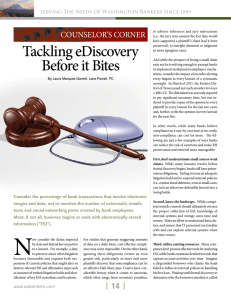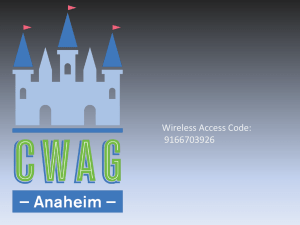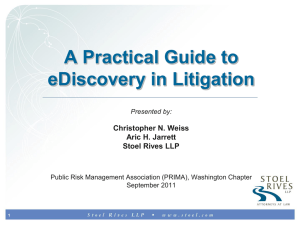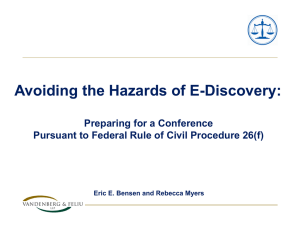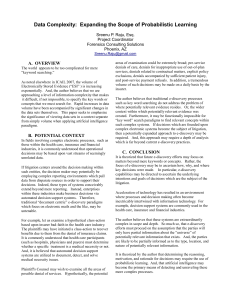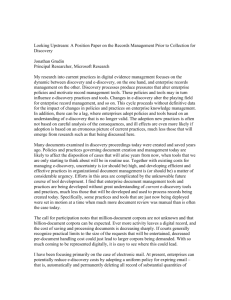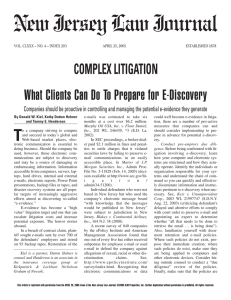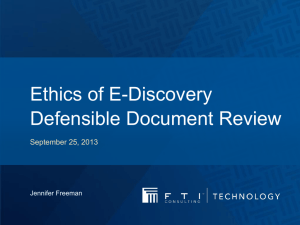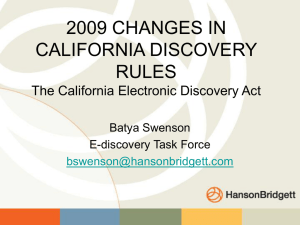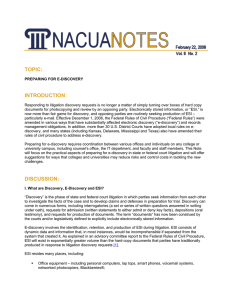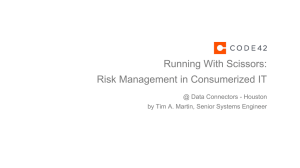PPT - Lease Enforcement Attorney Network
advertisement
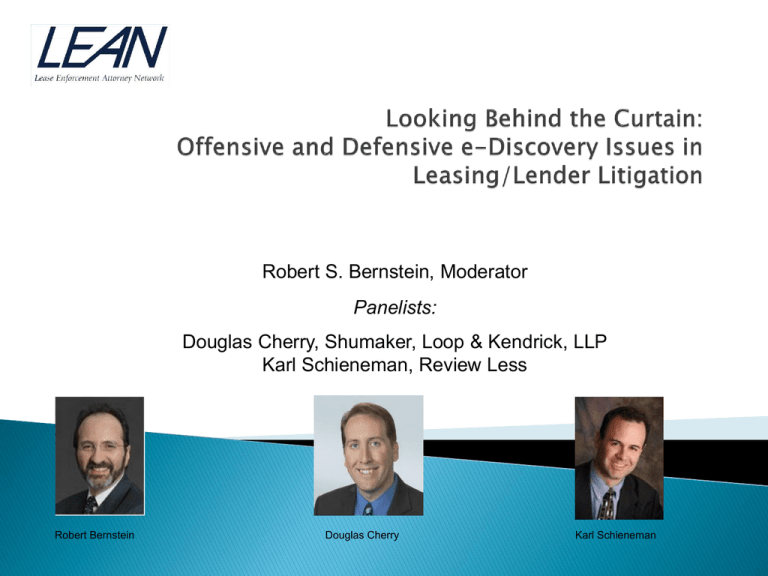
Robert S. Bernstein, Moderator Panelists: Douglas Cherry, Shumaker, Loop & Kendrick, LLP Karl Schieneman, Review Less Robert Bernstein Douglas Cherry Karl Schieneman Lean member Doug is a Partner in the intellectual property practice group in the Sarasota, Florida office of Shumaker, Loop & Kendrick, LLP. He is Board Certified in Intellectual Property Law. His practice primarily focuses on intellectual property and technology law, including consulting clients and attorneys in eDiscovery issues. He is chair of the Florida Bar BLS Civil Rules Subcommittee on Electronic Discovery and was involved in drafting the recently implemented "eDiscovery Amendments" to the Florida Rules of Civil Procedure. He is past chair of the Computer & Technology Law Committee of The Florida Bar. Mr. Cherry has authored many articles on IP and legal technology, including the article, "Success in Electronic Discovery," featured in Trial Magazine. Cherry has conducted seminars on related topics. He is a graduate of the UF College of Law. Karl is the President and Owner of Review Less is a Pittsburgh based electronic discovery consultancy that focuses on predictive coding. He assists companies with implementing predictive coding in a defensible manner and works with law firms in litigation with drafting predictive coding protocols and creating workflows. He is also a Special Master in the W.D. of Pennsylvania Special Master Pilot Program for Electronic Discovery. He has trained dozens of judges on advanced analytic review tools. He practiced law at Pittsburgh based Marcus & Shapira. He received an MBA from Carnegie Mellon University and graduated on Law Review and Cum Laude from the University of Pittsburgh School of Law. Some of his past honors include receiving an Ernst & Young Entrepreneur of the Year Award in 2004, a Vestige Award for Most Innovative Use of ESI in 2008 and has been involved with Inc. 5000 Award Winning Companies in 7 years with three different companies LEAN member Bob Bernstein, Managing Partner at BernsteinBurkley, P.C., has volunteered to moderate the webinar discussion. Bob is a qualified member of the panel of the e-discovery special masters for the Federal Court in the Western District of Pennsylvania and has been involved in and managed the review of a production of more than 8 million pages of documents, as well as having managed the autopsies of a number of bankrupt companies as plan administrator or commercial counsel. While fulfilling his duties as managing partner of BernsteinBurkley, P.C., Bernstein represents other businesses of all sizes and types in many areas of their operation, including representation in reorganization proceedings. He has extensive experience in credit recovery matters, including collection, secured transaction and mortgage foreclosure. Looking Behind the Curtain: Offensive and Defensive e-Discovery Issues in Leasing/Lender Litigation Today, most corporate information is created, edited, accessed, communicated, stored, and deleted electronically More information in electronic medium than paper Electronic data often never takes physical form (never printed) The Human Brain & Filing System = Metadata ◦ Information about the ESI. Application MetaData: Prior drafts and comments. Stuff in the background. Undo changes. Can embarrass you. System MetaData: File names, size, creation date, modification, usage. ◦ Rare: Can be evidence. Date logged into system. Maybe changing data which could be “modified by” metadata. Rare. ◦ More frequently: Can allow some intelligent guessing on what types of ESI to include in a case. Can make high end analytical search tools work better Its changing and you have to be prepared to keep up with it. What we do today with technology in life is different. This impacts E-Discovery. E.g. Facebook, Twitter, LinkedIn. E-Discovery Tools also change. Predictive Coding, Cloud Storage. What kind of evidence exists? ◦ Emails, documents, databases, server logs, web-browsing history, text messages, cell phone records, etc. Where is it? ◦ PCs (office and home), laptops, servers, the cloud, PDAs, cell phones, off-site storage, back-up tapes, chat rooms, CD-ROMs, zip disks, etc. Easy to search/manage ◦ If you know where all of it is. Difficult to delete ◦ Redundant information. ◦ Allocated space vs. unallocated space. ◦ Generally not deleted until overwritten. Nature of Electronic Evidence ◦ Emails. ◦ Social Media. ◦ Corporate website. ◦ Chance for a “smoking gun”. Can look at it all. - Simple contract dispute. Can Reduce Set: Dates, File Types, Custodians. Search Terms – Key Words. Go Fish ◦ False positives ◦ Misspellings ◦ Miss lots of documents. Predictive Coding: Build a spam filter with seeding of documents or random sampling. Concepts: Group similar documents together based on noun patterns. But search for a concept. Clusters: Visually group similar documents together. Automatically happens. Timelines: Look Email Threads: Grouping conversations together. 2006 E-discovery amendments to Federal Rules Rule 16 (initial status hearing with the court) and Rule 26 (initial conference between parties) Rule 26 (f)(3) (“Meet and Confer”) Why are these important? ◦ Lawyer must understand client’s electronic data. ◦ E-discovery cannot be ignored . ◦ New, undefined term…ESI. Understand client’s ESI (Electronically Stored Information) – Get organized! Preservation ◦ Document retention policies. ◦ Duty to preserve/suspend policy. Have a litigation hold plan with client ◦ Effectively handling the litigation hold letter. ◦ Zubulake V/Pension guidelines – not enough to send letter. ◦ Check local rules and case law. How far must you go to preserve? ◦ Forensic imaging? Effect of evidence preservation letter to opposing counsel? Consider strategies Be prepared for 26(f) conference ◦ Be more knowledgeable than your adversary. ◦ Consider addressing preservation scope and cost issues. ◦ Work together to avoid unnecessary discovery disputes. ◦ Do not misrepresent system’s capabilities or lack thereof. ◦ Identify inaccessible information? Understand opponent’s technology ◦ Records custodian deposition Know the right questions to ask Discovery ◦ Know what to ask for and in what format. ◦ Know the difference between a PDF and a PST. ◦ Keep in mind you may only get one bite at apple. ◦ Can we get their computer? ◦ Often in client’s best interest for counsel to cooperate. Manage expenses (not enough or too much?) Proportionality: A major governing principal. “Spoliation is the destruction or significant alteration of evidence, or the failure to preserve property for another's use as evidence in pending or reasonably foreseeable litigation.” Qualcomm Inc. v. Broadcom Corp., 2008 WL 66932 (S.D. Cal. Jan. 7, 2008) ◦ Outside counsel withholds tens of thousands of emails; deponent’s computer not searched prior to deposition, etc. ◦ Court sanctions Qualcomm $8,568,633 for discovery abuse. ◦ Orders certain in-house and former outside counsel to participate in "Case Review and Enforcement of Discovery Obligations" Program. ◦ Refers investigation of possible ethical violations to California State Bar. Qualcomm order imposing sanctions on 6 outside counsel later vacated. Issue remanded to magistrate to allow attorneys to fully defend their conduct Attorneys fees, Adverse Inferences, Evidence Exclusion, Striking of Pleadings, Default Judgment, Dismissal, Ethical Sanctions, Criminal Penalties (COURT’S INHERENT POWERS) Pension Committee of the Univ. of Montreal Pension Plan, et al. v. Banc of America Securities, LLC, et al., 2010 WL 184312 (SDNY 2010) ◦ "After a discovery duty is well established, the failure to adhere to contemporary standards can be considered gross negligence. Thus, after the final relevant Zubulake opinion in July, 2004, the following failures support a finding of gross negligence, when the duty to preserve has attached: 1) to issue a written litigation hold; 2) to identify all of the key players and to ensure that their electronic and paper records are preserved; 3) to cease the deletion of email or to preserve the records of former employees that are in a party's possession, custody, or control; 4) to preserve backup tapes when they are the sole source of relevant information or when they relate to key players, if the relevant information maintained by those players is not obtainable from readily accessible sources." ◦ "While litigants are not required to execute document productions with absolute precision, at a minimum they must act diligently and search thoroughly at the time they reasonably anticipate litigation." Contractually identify areas where lawyers typically have to negotiate into the lease. Precedent: Choice of law provisions, Choice of Venue, Jury Waivers, Arbitration Clauses. Jay Brudz & Jonathan Redgrave, Using Contract Terms To Get Ahead of Prospective E-Discovery Costs and Burdens in Commercial Litigation, XVIII RICH. J.L. & TECH. 13, http://jolt.richmond.edu/v18i4/article13.pdf Absence of preservation duty unless a notice or request to preserve is served on the party. 1. ◦ ◦ $30K per GB Sedona Estimate. Microsoft estimate: For each page of trial exhibit, they produce 1,000 pages, manually review 4,500 pages, collect and process 90,000 pages, and preserve 340,000 pages. Limitations on the amount of discovery allowed, including the amount of preservation. 2. ◦ ◦ ◦ Back up media Forensic examination of deleted data Limitations of custodians to 5 absent showing of good cause. Mechanics governing preservation & production decisions into a predictable framework 3. ◦ ◦ Call for neutral party to Mediate claims or Special Master to tap into e-discovery expertise. Limit use of key words or agree to predictive coding. Procedures allocating the costs for ordinary and extraordinary discovery. 4. ◦ ◦ Provide mechanics for fee shifting. Create mutual incentives to control costs. Agreed restrictions on sanctions for purported discovery failures. 5. ◦ Eliminate the risks of failure or mistake, no matter how innocent, turning into negligence resulting in monetary damages, adverse instructions to jury or dismissal of a claim. Untested idea Public Policy ◦ Discovery is not constitutionally mandated. ◦ Not barring claims Unconscionability ◦ So one sided Tort Claims Understand advantages of getting electronic information Recognize sources of ESI Failure to understand client’s electronic data or records system is no longer an option Create a litigation hold strategy in advance Consider creating record retention policies for clients In order to benefit from e-discovery, you must know what to ask for Education will benefit your clients as well as you • • • Consider lease provisions related to ediscovery. Parties can contract to mitigate risk. This is a very progressive idea which lawyers are starting to talk about. Have someone who understands technology involved in the process. Lawyers are generally not proficient in this area. Do not treat your technologists as an order taker. When discussing how to tackle a case efficiently, allow and encourage the discussion of ideas guided by a principle of what seems reasonable, which is usually the standard we are held to. • Create legal hold and preservation policies and follow them. • Prepare ediscovery policies in advance which include processes for data remediation. The only nationwide network of law firms specializing in lease enforcement and recovery Legal expertise Strategic locations Cost effective solutions Find out how LEAN can help your bottom line. Call 877-LEASE-LAW for a complimentary referral or visit us at www.leasecollect.org. Questions? Thank You. www.leasecollect.org
